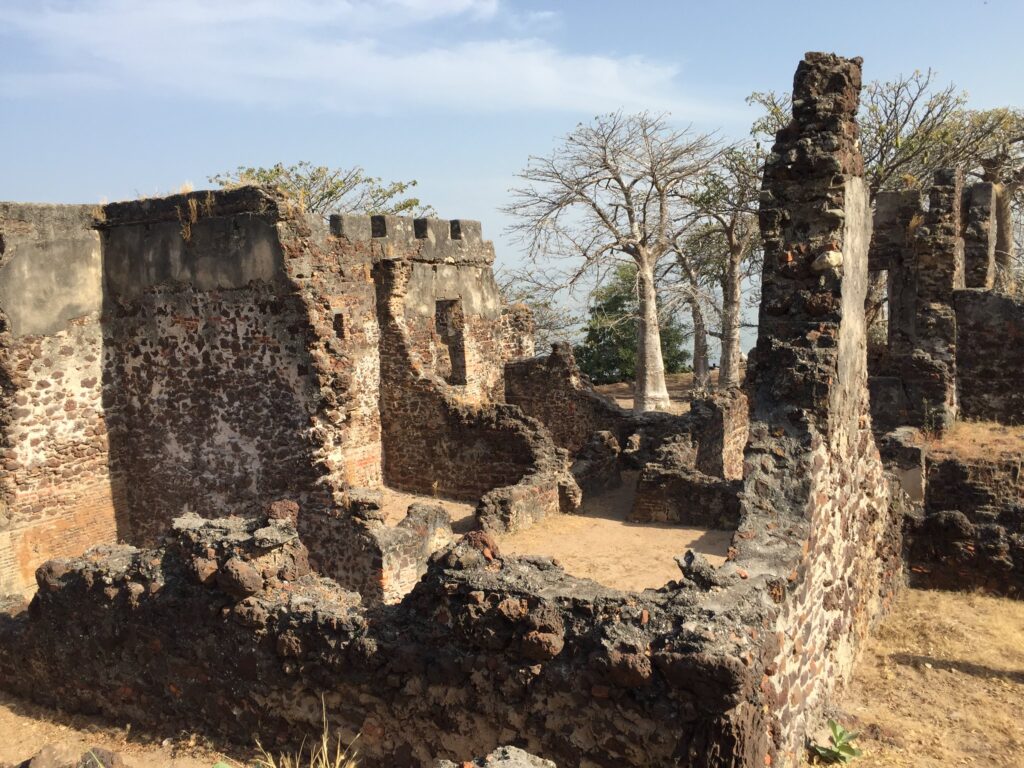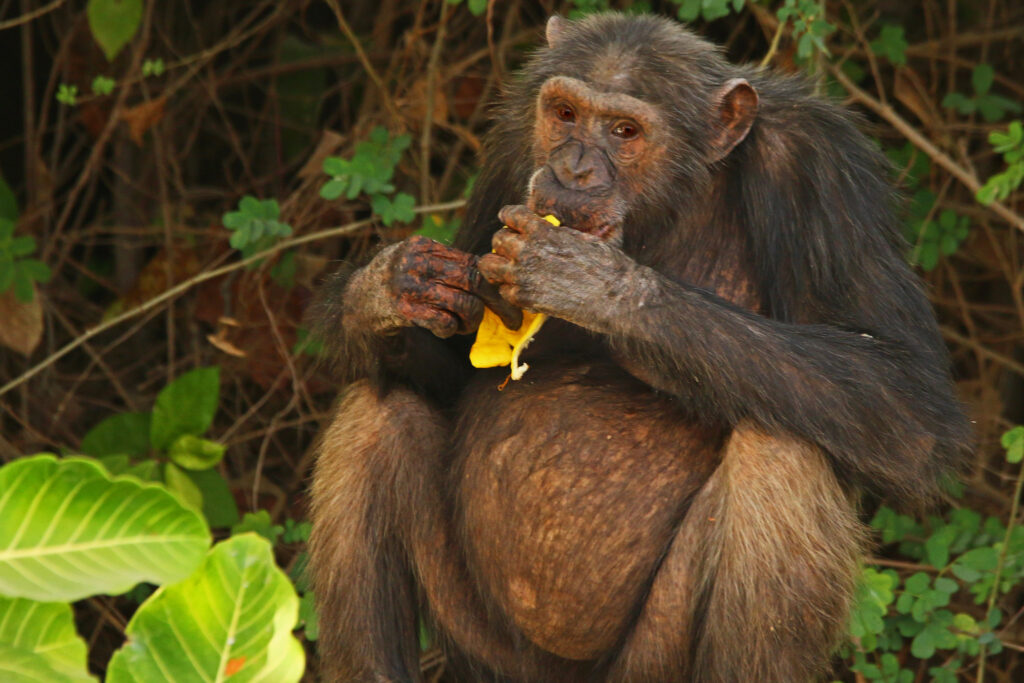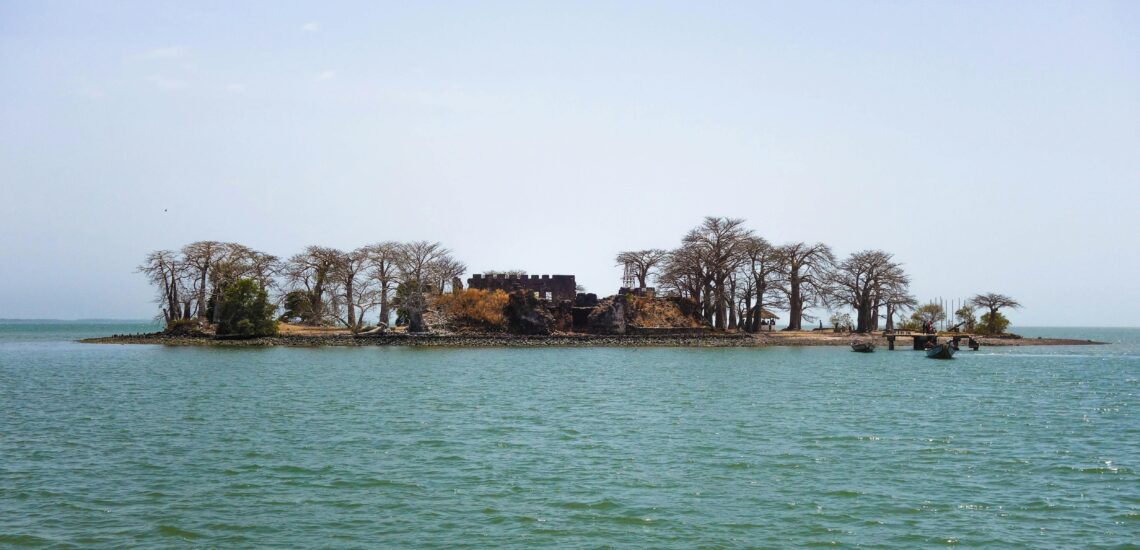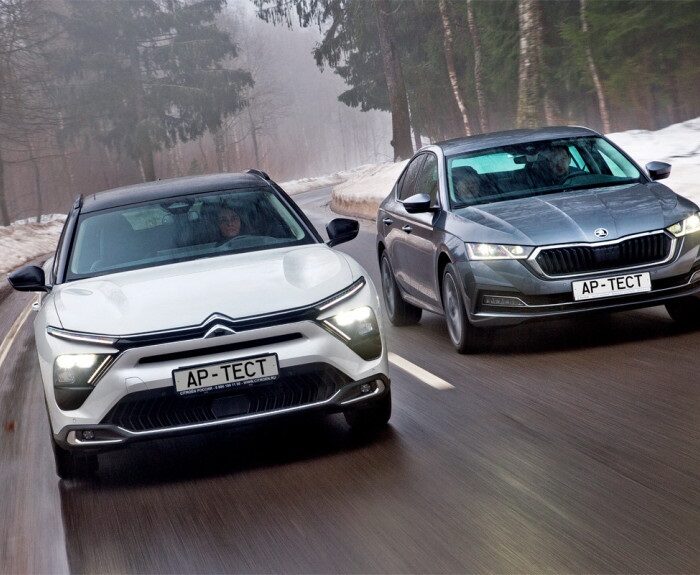Quick facts about The Gambia:
- Population: Approximately 2.7 million people.
- Capital: Banjul.
- Largest City: Serekunda.
- Official Language: English.
- Other Languages: Mandinka, Wolof, Fula, and other indigenous languages.
- Currency: Gambian dalasi (GMD).
- Government: Unitary presidential republic.
- Major Religion: Islam, with a small Christian population.
- Geography: Located in West Africa, Gambia is the smallest country on the African mainland, surrounded by Senegal, except for its coastline along the Atlantic Ocean. The country follows the path of the Gambia River, which is central to its geography.
Fact 1: The Gambia has an amazing shape inside Senegal along the river
The Gambia has a unique geographical shape, as it is an elongated country that runs along the Gambia River in West Africa, entirely surrounded by Senegal except for its small coastline along the Atlantic Ocean. The Gambia’s borders stretch in a narrow strip approximately 480 kilometers (300 miles) long, but it is only about 50 kilometers (30 miles) wide at its widest point. This gives it a distinctive, almost snake-like shape.
The country’s shape was determined during the colonial period when it was established as a British protectorate, and it was defined by the course of the Gambia River, which was an important trade route. The river flows from the Atlantic Ocean inland through the country, and it remains central to The Gambia’s geography, culture, and economy.

Fact 2: The Gambia River has diverse animal life
The river and its surrounding wetlands and forests support diverse species, including hippos, crocodiles, and manatees in the water, while the riverbanks and nearby forests host a variety of monkeys, baboons, and even leopards. The river is also a habitat for numerous bird species, making it a popular spot for birdwatching, with notable species such as African fish eagles, kingfishers, and herons.
The river’s biodiversity is not only a vital part of the ecosystem but also draws ecotourism to The Gambia. The protected areas along the river, such as Kiang West National Park and River Gambia National Park, help preserve these habitats and provide safe areas for wildlife to thrive, contributing to conservation and environmental awareness in the region.
Fact 3: The Gambia has 2 UNESCO World Heritage Sites
The Gambia is home to two UNESCO World Heritage Sites:
- Kunta Kinteh Island and Related Sites: Inscribed in 2003, this site includes Kunta Kinteh Island (formerly James Island) in the Gambia River, along with surrounding fortresses, trading posts, and colonial buildings along the riverbanks. These sites bear historical significance as they are connected to the transatlantic slave trade, serving as locations where enslaved Africans were held before being shipped to the Americas. The island and its structures stand as a stark reminder of this tragic chapter in human history.
- Stone Circles of Senegambia: Also inscribed in 2006, these stone circles are located in both The Gambia and Senegal and consist of over 1,000 monuments that form part of ancient burial sites. Dating back over a thousand years, the circles, such as those at Wassu and Kerbatch in The Gambia, reflect a rich prehistoric culture and are believed to represent complex burial practices and social structures.
Note: If you plan to visit the country and its attractions, check in advance if you need an International Driving Permit in The Gambia to rent and drive a car.

Fact 4: The Gambia’s highest point is only 53 meters (174 feet)
With much of its land at low elevations and lying along the Atlantic coastline, The Gambia is highly vulnerable to rising sea levels and other effects of climate change.
The threat is particularly severe in the capital city, Banjul, which sits near the mouth of the Gambia River and is at risk of coastal flooding and erosion. Rising sea levels could have devastating impacts on agriculture, fisheries, and freshwater resources, all of which are critical to the country’s economy and food security. Coastal communities may face displacement as saltwater intrusion threatens farmlands, while tourism—an important economic sector—could be adversely affected.
Fact 5: There is chimpanzee research in The Gambia
Сhimpanzee research is ongoing in The Gambia, particularly through the Chimpanzee Rehabilitation Project (CRP), located within River Gambia National Park. Established in 1979, this sanctuary works to protect and rehabilitate chimpanzees, many of whom were orphaned or rescued from captivity. The CRP provides a safe, semi-wild habitat on three islands within the river, where the chimpanzees can thrive with minimal human interference.
Famous chimpanzee Lucy was a chimpanzee raised as part of an experiment in the United States to examine language and behavior in great apes. She was eventually relocated to The Gambia as an adult when it became clear she couldn’t reintegrate into the wild in her home environment. Her adjustment was challenging, and her story has been widely discussed in research on primate behavior and the ethics of such experiments.

Fact 6: For bairdwatching, this is the place to be
The Gambia is a premier destination for birdwatching and is often called a “birdwatcher’s paradise.” With over 560 recorded bird species, the country is rich in avian diversity, attracting enthusiasts from around the world. Its small size and the concentrated variety of habitats—from mangroves and coastal wetlands to savannas and woodlands—make it easy for birdwatchers to spot a large number of species in a relatively short time.
Popular birdwatching spots include Abuko Nature Reserve, Tanji Bird Reserve, and Kiang West National Park. The banks of the River Gambia and the lush surroundings of Kotu Creek are also excellent locations for sightings. Among the most sought-after birds are the African fish eagle, blue-breasted kingfisher, and the Egyptian plover.
Fact 7: There is a sacred place with crocodiles in The Gambia
The Gambia is home to the Kachikally Crocodile Pool, a sacred site in the town of Bakau that attracts both tourists and locals. This pool is believed to have spiritual significance, especially among the Mandinka people, who consider the crocodiles here to be symbols of fertility and good fortune. People visit the pool to seek blessings, particularly for fertility, health, and prosperity.
The crocodiles at Kachikally are remarkably tame and accustomed to human presence, allowing visitors to approach and even touch them—a rare experience given that crocodiles are usually highly dangerous. The site also features a small museum with artifacts that tell the history of the local culture and the pool itself. The Nile crocodile is the main species found in Kachikally, though these particular animals are specially cared for and fed to ensure they pose no threat to visitors.

Fact 8: Ballots were and sometimes still are voted on here
In The Gambia, voting with marbles (or ballots in the form of small balls) has been a distinctive method used for decades. This system was introduced in 1965 to ensure a simple, accessible, and illiteracy-friendly voting process for a population where literacy rates were initially quite low. In this system, voters place a marble into the drum or container assigned to their chosen candidate, each container marked by a photograph or symbol to represent the candidate.
This method was widely regarded as straightforward and effective, minimizing the chances of ballot tampering and errors in counting. Although many countries have adopted digital or paper ballot systems, The Gambia’s use of marbles or “ballots” persisted into the 21st century.
Fact 9: The Gambia doesn’t have a very long coastline but has beautiful beaches
The Gambia has a relatively short coastline of about 80 kilometers along the Atlantic Ocean, but it is lined with beautiful, sandy beaches that attract tourists from around the world. The most popular beaches include Kololi Beach, Kotu Beach, and Cape Point, which are known for their soft sands, gentle waves, and palm-fringed shorelines. These beaches are ideal for sunbathing, swimming, and enjoying water sports like fishing and kayaking.
In addition to beach relaxation, the coast is known for its vibrant beachside markets, lively local music, and fresh seafood. Many resorts and eco-lodges have been developed along the coast, making it a well-loved destination for travelers seeking both natural beauty and cultural experiences in West Africa.

Fact 10: The name of the capital came from a local plant
Specifically, the name is thought to derive from the Mandinka word “bang julo,” which refers to fiber from a reed or rope plant that grows in the region. This plant was historically important for making rope, which was widely used for various purposes, including in the construction of fishing nets.
Originally, Banjul was called Bathurst during the colonial era, named after the British Secretary of State for War and the Colonies, Henry Bathurst. In 1973, several years after independence, the city was renamed Banjul to reflect its local heritage and cultural roots.

Published November 10, 2024 • 7m to read





